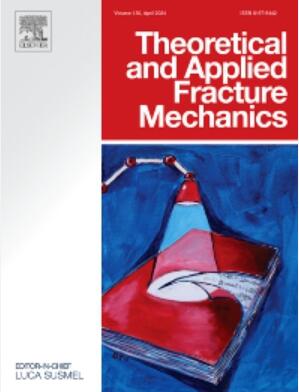冻融循环对纳米二氧化硅改性高强度高延展性碱活性材料断裂行为的影响
IF 5
2区 工程技术
Q1 ENGINEERING, MECHANICAL
引用次数: 0
摘要
纳米二氧化硅(NS)能有效改善水泥基材料和碱活性材料的力学性能,但其对高导混凝土耐久性和断裂性能的影响尚未被揭示。本文研究了冻融循环对 NS 改性高强高导碱活性材料(HSHDAM)弯曲断裂行为的影响。共评估了 4 种 NS 重量含量(0%、4%、8% 和 12%)和 4 种冻融循环次数(25、50、75 和 100)。结果表明,随着冻融循环次数的增加,HSHDAM 的抗压强度、动态弹性模量、起始断裂韧性、不稳定性断裂韧性和断裂能均持续显著下降,但延性指数有所上升。随着NS重量含量的增加,HSHDAM的抗压强度、动态弹性模量、起始和不稳定断裂韧性、断裂能和延性指数均持续上升,而弯曲强度似乎在NS含量为4%时达到最佳。75 次冻融循环是 NS 对弯曲强度和延展性指数产生强化作用的临界值。添加 NS 后,聚乙烯纤维更好的粘结性能、更充分的开裂行为以及碱激活基体的致密性都有助于实现这些良好的断裂和抗冻融行为。添加 NS 可以缓解冻融循环对 HSHDAM 力学性能和断裂性能的影响。本文章由计算机程序翻译,如有差异,请以英文原文为准。
Influence of freeze–thaw cycles on fracture behaviors of Nano-SiO2 modified high-strength high- ductility alkali-activated material
Nano-SiO2 (NS) can effectively improve the mechanical properties of cement-based materials and alkali-activated materials, but its effect on the durability and fracture properties of high-ductility concrete has not been revealed. The influences of freeze–thaw cycles on the bending fracture behaviors of NS modified high-strength high-ductility alkali-activated material (HSHDAM) were studied herein. There were 4 wt content of NS (0 %, 4 %, 8 % and 12 %) and 4 numbers of freeze–thaw cycles (25, 50, 75 and 100) assessed. The results indicated that with the increase of freeze–thaw cycles number, the compressive strength, dynamic modulus of elasticity, fracture toughness of initiation and instability and fracture energy of HSHDAM were all decreased continually and significantly, but the ductility index was increased. With the increase of the NS weight content, the compressive strength, dynamic modulus of elasticity, fracture toughness of initiation and instability, and fracture energy and ductility index of HSHDAM were all increased continually, while the bending strength seems to be optimal at 4 % NS content. 75 freeze–thaw cycle was the threshold value for the strengthening effect of NS on bending strength and ductility index. With the addition of NS, the better bonding properties of polyethylene fiber, more fully cracking behaviors, and compact alkali-activated matrix contributed to these good fracture and anti-freeze–thaw behaviors. The addition of NS can alleviate the deterioration of HSHDAM mechanics and fracture properties caused by freeze–thaw cycle.
求助全文
通过发布文献求助,成功后即可免费获取论文全文。
去求助
来源期刊

Theoretical and Applied Fracture Mechanics
工程技术-工程:机械
CiteScore
8.40
自引率
18.90%
发文量
435
审稿时长
37 days
期刊介绍:
Theoretical and Applied Fracture Mechanics'' aims & scopes have been re-designed to cover both the theoretical, applied, and numerical aspects associated with those cracking related phenomena taking place, at a micro-, meso-, and macroscopic level, in materials/components/structures of any kind.
The journal aims to cover the cracking/mechanical behaviour of materials/components/structures in those situations involving both time-independent and time-dependent system of external forces/moments (such as, for instance, quasi-static, impulsive, impact, blasting, creep, contact, and fatigue loading). Since, under the above circumstances, the mechanical behaviour of cracked materials/components/structures is also affected by the environmental conditions, the journal would consider also those theoretical/experimental research works investigating the effect of external variables such as, for instance, the effect of corrosive environments as well as of high/low-temperature.
 求助内容:
求助内容: 应助结果提醒方式:
应助结果提醒方式:


